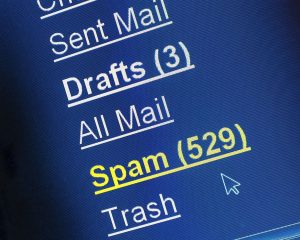Sendgrid is a Simple Mail Transfer Protocol (SMTP) provider that allows users to send email without maintaining email servers. But as useful as it is, some users may notice in their control panel that some messages failed to send. So they ask, “Why are my SendGrid emails going to spam?”
In this blog post, we’ll share with you the common reasons why your SendGrid emails are going to spam and what to do about it.
Ready? Let’s dive in!
5 Reasons Why Your SendGrid Emails Going to Spam
1. You Don’t Have an Unsubscribe Link
Adding an unsubscribe link to your SendGrid emails is important. Doing so allows you to remain on good terms with your customers even after they’ve left.
It also shows that you are polite to your customers, keep your list clean, comply with the CAN-SPAM Act if you’re in the US, and avoid the spam folder.
The list could go on, but the simple fact there is that you need an unsubscribe link. It would also be best if you could include a simple textbox near your unsubscribe link. Therefore, the user can share his or her reason why they want to leave.
2. You Didn’t Follow the Authentication Steps
Domain authentication (formerly called the domain Whitelabel) shows email providers that SendGrid permits you to send emails on your behalf.
To give SendGrid permission, you need to point DNS entries from the DNS provider (like Cloudflare, Rackspace, or GoDaddy) to SendGrid.
DNS entries or records are instructions in DNS servers. They provide information about the domain, such as what IP is linked with that domain and how to handle requests coming for that domain.
This simple change can create a positive impact on your sender’s reputation and even your email deliverability. Email service providers distrust emails that don’t have sender authentication set up because they are not sure that the message comes from you.
3. You’re Using an IP Pool
IP pools are dedicated IP addresses utilized to manage the sending reputation of individual mail streams. Using IP pools protects the sending reputation of your important emails.
However, if anyone in the list of the IP pool reports spam, it’s possible that other users within the pool may also be affected.
4. Your Click-Tracking Domains Have Low Reputation
Similar to the domain and IP reputation, click-tracking domains are another factor that can get your emails to the spam folder.
Basically, it’s the reputation of the domains you use in URLs or links within your email.
Let’s say you used the link “http://yourdomain.com/contactus.html” in your email. But if you use SendGrid’s click-tracking feature, you will see how the platform masks the links to something like http://ct.sndgrid.net/wf/click?upn=sdfsdfsfsd.
To find out if this is why your SendGrid emails are going to spam, you can open any email you received from SendGrid when you conducted an email test via mail tester and look for URLs. Check the reputation of such links on platforms like MultiRBL or GradeMyEmail.
5. You’re Using Non-HTTPS Links That Trigger Spam Filters
Some Internet Service Providers have already started giving preference to HTTPS links within the emails rather than HTTP. It’s because it comes with encryption and is more secure.
In case of a URL redirect (sending the user from one URL to another), we encourage you to ensure that the source and landing URLs are on HTTPS. Redirecting from an HTTP URL to an HTTPS URL could also likely get your emails flagged as spam or suspicious, most especially in Gmail.
Moreover, web users may be redirected to another URL for various reasons. This includes a change of business name, to direct traffic to recently updated content, landing page split testing, to direct content to an updated domain name, or a merger of two websites.
8 Ways to Combat SendGrid Emails Going to Spam
1. Have a Healthy Image-to-Text Ratio
Although there’s no exact formula as to what is the right image-to-text ratio, remember that using image-heavy emails increases your chance of triggering the mail servers’ spam filters. So, try to achieve a 2:1 ratio of words to images.
Having an alt attribute in your image tags would also be best. Since images don’t always show by default in emails, putting an alternative text will be a good idea. Doing so helps recipients to no longer authorize it first before the images appear.
In addition, it helps you avoid the spam folder, as most spammers don’t take the time to use an alt attribute. Thus, it will increase your chance of landing it in your recipients’ inboxes.
2. Personalize Emails
Spam filters are looking for similarities in your emails. If you want to avoid triggering the filters, increase the uniqueness of your emails by adding a personalized element.
3. Separate Transactional Content from Marketing Content
Separating transactional content from marketing content is strongly recommended. Doing so prevents from your receivers mistaking the nature of your messages and marking them as spam.
4. Your IP Should Be Clean
As you probably know, your sending reputation is a huge part of successful email deliverability. This indicates how your subscribers are responding to your messages, such as how often they send or delete your messages.
In addition, your sending domain reputation is dependent on a few metrics, such as block rates, open rates, engagement rates, and spam reports. It is also best that your IP is properly warmed up, clean, and with reverse DNS set up.
5. Whitelabel Your Email Links and Domain
If you are a SendGrid customer and your emails are landing as spam instead of inbox, it’s likely that you’re sending a message with a “Reset your password” link. This link usually comes from a non-white-labeled email address or the link you’re using from a different URL.
To solve this, set up domain authentication. Go to your SendGrid account and submit the DNS records to your hosting provider or DNS.
Here’s a complete list from SendGrid on how you can get started with domain authentication.
6. Try Turning Off Your “Click Tracking” Setting in the Dashboard
Another reason why your SendGrid emails are marked as spam is that your anchor label is not the same as the href being called. However, you can solve this by checking your click-tracking setting in the SendGrid dashboard.
If you have something like this: <a href=”http://yourdomain.com“>yourdomain.com</a>, SendGrid might replace it and you’ll end up with:
<a href=”http://sendgrid.net/….<very-long-url>…….”>yourdomain.com</a>.
So, try turning off your click-tracking setting and see if it redirects the link to the URL you originally set.
This means you have to test your deliverability after turning off the click-tracking setting. Some spam checkers will even provide you a preview rating based on how frequently your emails trigger the spam filters.
7. Measure Your Email Marketing Success Using Metrics
Email performance and metrics are the tried and tested ways to know how well your email marketing campaigns are improving and progressing. Although, it is necessary to understand your baseline metrics before you use these KPIs.
So, start with these basic metrics like spam complaints, click-through rates, open rates, and delivery rates. As you start tracking these email metrics and you notice negative trends, don’t panic.
The important thing you can do is act calmly and quickly to remedy the problem. Let’s say your open rates are dropping. Then, review your email frequency and subject lines first. Often, these two variables have the most significance on your metric.
8. Maintain a Healthy Email List
When you are sending your emails, it is best to send them to a targeted email list and the email addresses there must be healthy.
Simply put, the emails there are valid, there are no spam traps, try to achieve an almost 0% complaint rate, and determine the active users.
For example, when you send an email, how many users click the links or how many users open it?
Another good practice is to delete all inactive email addresses every two to three months. Sending emails to these inactive users will only hurt your overall email deliverability, not just your email list.
Land Your SendGrid Emails in the Inbox!
Okay, friends. Now that you know the rules of the game, you can surely prevent your SendGrid emails from going to spam to land in the inbox successfully!
But if you think all these sending practices are a terrible amount of work, you can always hire someone else to do it for you. Or you can change the platform and redo all your email workflows.
Honestly, there are many other and better platforms when it comes to deliverability. Athough, others come with a price.
Other related articles:

